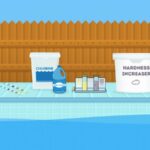The best method for clearing up your water is the same for all three types of algae with just one exception.
1. Vacuum Your Pool Manually
Automatic or robotic pool cleaners aren’t well suited to cleaning algae. Ideally, you’ll manually vacuum directly to waste, bypassing your filter and preventing recirculation of your contaminated water. When you vacuum your pool manually, pay special attention to areas with algae.
2. Brush Your Pool Walls and Floor
Scrubbing the algae off your pool walls lets your sanitizer get deeper into the remaining algae. It also stirs up the sediment you’ve brushed off so it can be killed and filtered out.
Using a stiff pool brush on a pole, brush the walls and floor of your pool. Pay special attention to corners and shady areas where algae is usually worst. As you go, your water will become cloudy, obstructing your view, so get those tough spots first.
3. Test and Balance the Water
Use your test strips, digital kit, or liquid kit to test your alkalinity and pH. Balancing your water chemistry now ensures your sanitizer will be effective against the algae. High pH or low alkalinity will especially inhibit pool shock.
4. Shock Your Swimming Pool
More resistant types of algae require more aggressive treatment, so if the infection is heavy, you’ll need more shock.
Even if you don’t normally use chlorine shock, for this purpose, it’s best to use calcium hypochlorite shock—and lots of it. Follow the package instructions to determine the dose for your pool size, then multiply that by two, three, or four depending on which type of algae you’ve got.
Don’t use stabilized chlorine to shock your pool. You’ll end up with too much cyanuric acid, which inhibits sanitizer, and can lead you right back to algae in your pool, or other, worse problems.
5. Filter Out The Pool Algae
When your shock treatment kills the algae, it’ll turn your water a cloudy blue. Run your filter continuously for a minimum of eight hours until the water clears up.
You may add pool water clarifier to speed up the process. Be sure to check whether you need to top off your water before turning on the pump.
6. Test Your Pool Water Again
You may use your usual test methods or run a water sample to your local pool store for analysis. You want to be sure your water chemistry is balanced and your chlorine level is back to normal before anyone gets back into the water.
7. Clean Your Pool Filter
The last thing you want is a filter full of particles slowly filling your pool back up with microscopic algae that could start another bloom. Deep clean your filter by soaking it in diluted muriatic acid, or simply replace it.





